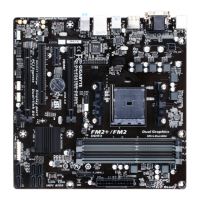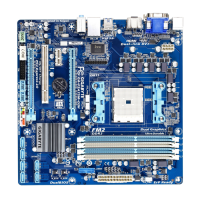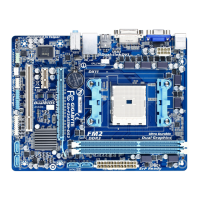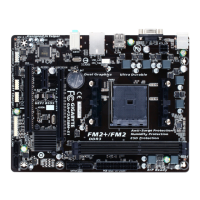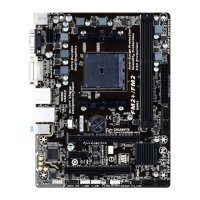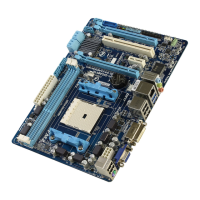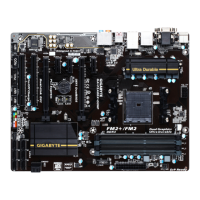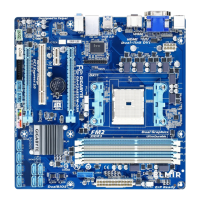Do you have a question about the Gigabyte GA-F2A78M-HD2 and is the answer not in the manual?
Essential safety and handling guidelines for installation.
Precautions and steps for APU installation.
Precautions and steps for memory installation.
Hardware and software prerequisites for dual graphics.
BIOS settings for enabling AMD Dual Graphics.
Overview of BIOS purpose and how to enter Setup.
Displays current system frequencies and voltages.
Controls for CPU, graphics, and North Bridge frequencies.
Fine-tuning CPU core frequency and ratio.
Settings for performance boost, cooling, virtualization, and core control.
Configuring XMP/AMP profiles and memory multipliers.
Settings for memory timings, interleaving, and voltage.
Monitoring system health and controlling fan speeds.
Configuring boot device priority and BBS priorities.
Configuring support for graphics, USB, PS/2, and network boot.
Settings for Windows 8 features, CSM, and boot modes.
Configuring IOMMU, USB, onboard audio, and LAN.
Settings for primary video and integrated graphics.
Configuring resume by alarm, HPET, and AC power recovery.
Settings for keyboard/mouse wake-up and power saving.
Options to save settings, exit without saving, or load defaults.
| Memory voltage | 1.5 V |
|---|---|
| Memory channels | Dual-channel |
| Memory slots type | DIMM |
| Number of memory slots | 2 |
| Supported memory types | DDR3-SDRAM |
| Maximum internal memory | 64 GB |
| Supported memory clock speeds | 1333, 1600, 1866, 2133, 2400 MHz |
| Processor socket | Socket FM2 |
| Processor manufacturer | AMD |
| Compatible processor series | AMD A |
| Maximum number of SMP processors | 1 |
| S/PDIF out connector | Yes |
| Number of SATA III connectors | 4 |
| Number of Parallel ATA connectors | 0 |
| RAID levels | 0, 1, 10, JBOD |
| Supported storage drive interfaces | SATA III |
| HDMI version | 1.4a |
| USB 2.0 ports quantity | USB 2.0 ports have a data transmission speed of 480 Mbps, and are backwards compatible with USB 1.1 ports. You can connect all kinds of peripheral devices to them. |
| Component for | PC |
| Power source type | ATX |
| Motherboard chipset | AMD A78 |
| Audio output channels | 7.1 channels |
| Motherboard form factor | micro ATX |
| Maximum resolution | 2560 x 1600 pixels |
| Maximum graphics card memory | 2048 MB |
| Parallel processing technology support | - |
| BIOS type | UEFI AMI |
| ACPI version | 2.0a |
| BIOS memory size | 16 Mbit |
| Bundled software | Norton® Internet Security (OEM) |
| Depth | 174 mm |
|---|---|
| Width | 226 mm |


